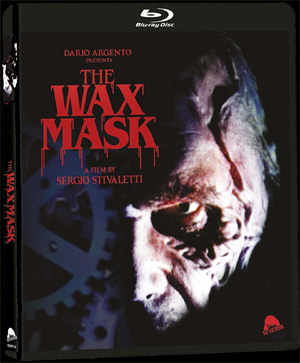 WAX
MASK (1997) Blu-ray
WAX
MASK (1997) Blu-rayDirector: Sergio Stivaletti
Severin Films
 WAX
MASK (1997) Blu-ray
WAX
MASK (1997) Blu-rayItalian horror pays homage to the classics with the gory throwback WAX MASK, on Blu-ray from Severin Films.
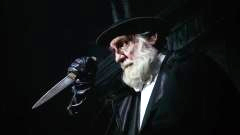
The wax museum of horrors of Dr. Boris Volkoff (Robert Hossein, THE VAMPIRE OF DUSSELDORF) is set to open in turn-of-the-century Rome, and its notoriety is heightened by the seeming death from fright of young student Luca (effects artist Daniele Auber) who took a bet from his colleagues to spend the night there. As the grand opening nears, a number of disappearances beset the city, including the apparent death of a young waif (Stefania Fidotti) who wakes up on the autopsy table and tells of an assailant with an iron hand. Unable to find any leads, detective inspector Lanvin (Aldo Massasso, LET SLEEPING CORPSES LIE) encourages the swaying of public opinion by the news story of reporter Andrea (Riccardo Serventi Longhi, THE THREE FACES OF TERROR). The story of the iron hand resonates with seamstress Sonia (Romina Mondello, MARQUISE) who as a child witnessed the brutal evisceration murders of her parents twelve years prior in Paris by such an assailant. Sonia is now working as a costume designer at the museum where boyfriend Andrea sees a resemblance between the wax figure of a victim of Jack the Ripper and the vanished prostitute Giorgina (Valery Valmond) he questioned while investigating Luca's death. Sonia comes to suspect Volkoff but his affection for her makes the attempt on her life seem unlikely, but his apprentice Alex (Umberto Balli) has the eye for ideal models for the museum's wax figures and jealousy guards his working relationship with Volkoff.
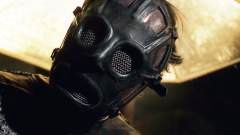 Although
it owes debts outright to THE MYSTERY OF THE WAX MUSEUM and its 1953 remake
HOUSE OF WAX – probably the more likely source since American and British
horror films of the 1950s and 1960s were more acknowledged influences on the
golden age of Italian horror – WAX MASK was announced as a new Italian
horror film to be produced by Dario Argento (OPERA) and directed by Lucio Fulci
(ZOMBIE) who passed away during pre-production (Grindhouse Releasing's Sage
Stallone was rumored to be in the cast when Fulci was involved) whereupon visual
effects designer Sergio Stivaletti (DEMONS) was promoted to director. The screenplay
by late period Fulci collaborator Daniele Stroppa (VOICES FROM BEYOND) uses
the Gaston Leroux source story "The Waxwork Museum" for the opening
act but the rest is a not so suspenseful mystery that seems to exist solely
to show off the wonderful period production design of Massimo Antonello Geleng
(THE CHURCH), the grisly make-up effects of France's Stivaletti equivalent Benoît
Lestang (BABY BLOOD), and the neat animatronics and ropier digital effects of
Stivaletti. The gorgeous cinematography of Sergio Salvati (CITY OF THE LIVING
DEAD) is full of German expressionist touches that unfortunately clash with
the inane English dubbing (the Italian version plays a bit more soberly), and
besides a climactic bit that seems patterned after TERMINATOR 2, a sequence
in which a character is confronted by and murdered by his wax masked double
unfortunately is less suggestive of FANTOMAS than DARKMAN (although one throwback
image is a bit closer to home referencing Mario Ciaino's NIGHTMARE CASTLE).
Despite the amount of onscreen gore, the film is rather lacking in any real
visceral feel that one associates with classic Fulci, although one wonders how
the film really would have come across had Fulci lived considering his latter
day productions; although the still low budget was certainly higher than any
that Fulci had to work with during the late eighties and early nineties. Rather
than a new Italian horror boom, WAX MASK is more of a handsome museum piece.
Although
it owes debts outright to THE MYSTERY OF THE WAX MUSEUM and its 1953 remake
HOUSE OF WAX – probably the more likely source since American and British
horror films of the 1950s and 1960s were more acknowledged influences on the
golden age of Italian horror – WAX MASK was announced as a new Italian
horror film to be produced by Dario Argento (OPERA) and directed by Lucio Fulci
(ZOMBIE) who passed away during pre-production (Grindhouse Releasing's Sage
Stallone was rumored to be in the cast when Fulci was involved) whereupon visual
effects designer Sergio Stivaletti (DEMONS) was promoted to director. The screenplay
by late period Fulci collaborator Daniele Stroppa (VOICES FROM BEYOND) uses
the Gaston Leroux source story "The Waxwork Museum" for the opening
act but the rest is a not so suspenseful mystery that seems to exist solely
to show off the wonderful period production design of Massimo Antonello Geleng
(THE CHURCH), the grisly make-up effects of France's Stivaletti equivalent Benoît
Lestang (BABY BLOOD), and the neat animatronics and ropier digital effects of
Stivaletti. The gorgeous cinematography of Sergio Salvati (CITY OF THE LIVING
DEAD) is full of German expressionist touches that unfortunately clash with
the inane English dubbing (the Italian version plays a bit more soberly), and
besides a climactic bit that seems patterned after TERMINATOR 2, a sequence
in which a character is confronted by and murdered by his wax masked double
unfortunately is less suggestive of FANTOMAS than DARKMAN (although one throwback
image is a bit closer to home referencing Mario Ciaino's NIGHTMARE CASTLE).
Despite the amount of onscreen gore, the film is rather lacking in any real
visceral feel that one associates with classic Fulci, although one wonders how
the film really would have come across had Fulci lived considering his latter
day productions; although the still low budget was certainly higher than any
that Fulci had to work with during the late eighties and early nineties. Rather
than a new Italian horror boom, WAX MASK is more of a handsome museum piece.

Released direct-to-DVD in the United States by Image Entertainment in a non-anamorphic but otherwise attractive transfer. While an anamorphic transfer appeared on Italian DVD, all other English-friendly editions were non-anamorphic until the sudden appearance of a Blu-ray from One 7 Movies – formerly the equally suspect MYA Communications label – which featured Italian and English Dolby TrueHD tracks with the reverting to Italian without subtitles for some dialogue that was present in English in earlier editions. Severin Films' 1080p24 MPEG-4 AVC 1.78:1 widescreen Blu-ray comes from the 4K scan of the original camera negative supervised by Stivaletti for an as-yet-unreleased French Blu-ray release. The image is a huge leap in improvement over the DVD editions (we have not seen the One 7 disc) but perhaps a tad too bright. This has the effect of heightening Geleng's period detail and the grue (and the various shades of red in the make-up and design) but black levels are very uneven and a couple shots of the background sky in day exteriors like the arrival of Giorgina at the abandoned villa and some long shots during the scene in which the cloaked killer lures a boy away look blown out. English and Italian audio tracks are included in DTS-HD Master Audio 5.1 and 2.0 stereo in good condition (good enough to recommend sticking to the Italian despite some familiar English-dubbing voices), and English subtitles for the Italian track are included along with SDH subtitles for the English dub. As with the One 7 Blu-ray, a couple lines still revert to Italian on the English tracks.
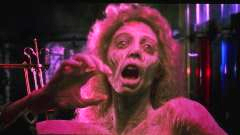 Severin's
Blu-ray is positively stacked with extras starting off with a fantastic audio
commentary by Stivaletti and his son Michelangelo Stivaletti (who had an in
utero cameo appearance in the film) moderated by David Gregory. Stivaletti clarifies
the degree of his involvement with the project when Fulci was involved, reveals
that he did not rewrite the screenplay but add onto it, including changing the
method of making the wax figure from the absurd concept of just dipping human
beings into wax and also reveals a lot of his historical research behind the
alchemical concepts including the finale's "robot" (which both Stivaletti's
do admit does recall THE TERMINATOR 2, the effects of which caused him to start
exploring CGI). He admits that he is not pleased with the CGI effects working
with the materials he had at the time, but also clarifies his contributions
to the film's make-up and mechanical effects from those of colleague Lestang.
He also reveals that the wax museum sets and laboratory were shot in inside
his own home and his silo workshop – the exteriors were lensed at the
Villa Borghese which has been featured in many "golden age" Italian
horrors like THE VAMPIRE AND THE BALLERINIA – and that he wanted colleague
Tom Savini to make an appearance in the film but he was unavailable but sent
a head cast which was used for the guillotine wax figure. He also discusses
details behind his as-yet unproduced sequel WAX MASK 2 which is set in Prague
and has its alchemist turning humans into mythological creatures.
Severin's
Blu-ray is positively stacked with extras starting off with a fantastic audio
commentary by Stivaletti and his son Michelangelo Stivaletti (who had an in
utero cameo appearance in the film) moderated by David Gregory. Stivaletti clarifies
the degree of his involvement with the project when Fulci was involved, reveals
that he did not rewrite the screenplay but add onto it, including changing the
method of making the wax figure from the absurd concept of just dipping human
beings into wax and also reveals a lot of his historical research behind the
alchemical concepts including the finale's "robot" (which both Stivaletti's
do admit does recall THE TERMINATOR 2, the effects of which caused him to start
exploring CGI). He admits that he is not pleased with the CGI effects working
with the materials he had at the time, but also clarifies his contributions
to the film's make-up and mechanical effects from those of colleague Lestang.
He also reveals that the wax museum sets and laboratory were shot in inside
his own home and his silo workshop – the exteriors were lensed at the
Villa Borghese which has been featured in many "golden age" Italian
horrors like THE VAMPIRE AND THE BALLERINIA – and that he wanted colleague
Tom Savini to make an appearance in the film but he was unavailable but sent
a head cast which was used for the guillotine wax figure. He also discusses
details behind his as-yet unproduced sequel WAX MASK 2 which is set in Prague
and has its alchemist turning humans into mythological creatures.
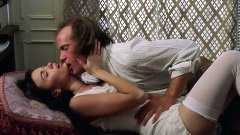
Severin carries over the extras from the Italian DVD editions including a subtitled behind the scenes montage (21:51) looking at the location shoots, the actors being made up and chatting with the camera and Stivaletti – including much ado about Argento's set visits – as well as a special effects workshop montage (12:31), and the short "On Set with Dario Argento" (4:17) in which we see Argento occasionally doubling as the killer's hand and collaborating with Stivaletti on the fire sequence. They have also produced a series of new featurettes which actually could have been edited together as a feature-length retrospective featuring the commentary of Stivaletti, Argento, producer Giuseppe Colombo (THE STENDHAL SYNDROME), production designer Gelent, and actress Giorgelli. “Beyond Fulci” (20:38) has Argento recalling meeting Fulci at a film festival, Colombo recalls the pair pitching projects to him and settling on Leroux after determining that they could not bring anything to a mummy film, pre-production clashes between the two, Stivaletti trying to sway Fulci away from the "human candle" aspect of dipping victims in wax and having actors posing as statues rather than doing body casts, and Fulci's sudden death. Claudio Fragasso (AFTER DEATH) also appears to reveal that Argento initially told him that Fulci wanted him to replace him on the film but he thought the project too complicated with only two weeks of prep and took a RAI miniseries instead. “The Chamber of Horrors” (20:53) looks at Stivaletti stepping into the director's role with two weeks of prep, dropping Fulci's idea to shoot in Turin when he realized that the budget would not stretch as far as he anticipated when just doing effects, collaborating with Geleng on sets and locations, and adding Lestang to his crew for the film (he also reveals that it was Lestang in the goat devil suit during the climax of THE CHURCH so Argento was comfortable with him and he fulfilled the French quota requirements). Colombo also recalls Argento clashing with Stivaletti in his role of supervising the inexperienced director, while both Argento and Giorgelli agree that Stivaletti was too shy to really command a production at the time. “Living Dolls” (18:54) looks at the shoot and casting, with the French co-production requirements brining in Hossein and Valmond, and Giorgelli recalling that Stivaletti liked her but Argento did not. “The Grand Opening” (10:16) has Argento and Colombo agreeing that the film did not do well in Italy but had good sales overseas on home video while Stivaletti is of the opinion that the film did well and chalks up any adverse reactions to the restrictive rating and people expecting Fulci rather than Stivaletti.
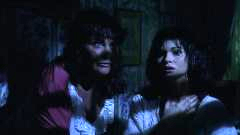 “The
Mysteries of the Wax Museum” (15:31) is a separate interview with Stivaletti
touching upon some of the same things in the commentary and aforementioned featurettes
while also elaborating on others, like initially wanting Stefania Rocca (THE
CARD PLAYER) for the lead and then realizing that Mondello was ideal for the
role when Rocca fortunately turned it down. “The Waxworks Symphony”
(17:28) is an interview with composer Maurizio Abeni who was working at CAM
when he met Stivaletti. He discusses the solo scoring assignment and having
not so much a theme as bits and pieces that came together as one, and is also
hard-pressed to identify specific inspirations (he thinks he may have been inspired
by Hammer scores but notes at the time that he did not feel like seeking any
out and listening to them with the short composing schedule. “Wax Unmasked”
(11:55) is an interview with critic Alan Jones who covered the production and
surmises that pretty much all of Argento's producing efforts with Stivaletti,
Lamberto Bava, and Michele Soavi were "helping friends out" –
suggesting that Argento felt obliged to get Fulci back behind the camera to
pay for his mounting hospital bills – but that they managed to produce
solid efforts out of it. There is no trailer for the film. A limited
edition of 4,000 copies includes a slipcover and CD soundtrack of Abeni's
score (not sure whether it is the original 1997 twenty track edition or Digitmovies'
2003 expanded twenty-four track version, or The
Wax Mask Bundle with a movie-themed keychain, sticker, and 5”x7”
lenticular print.
(Eric Cotenas)
“The
Mysteries of the Wax Museum” (15:31) is a separate interview with Stivaletti
touching upon some of the same things in the commentary and aforementioned featurettes
while also elaborating on others, like initially wanting Stefania Rocca (THE
CARD PLAYER) for the lead and then realizing that Mondello was ideal for the
role when Rocca fortunately turned it down. “The Waxworks Symphony”
(17:28) is an interview with composer Maurizio Abeni who was working at CAM
when he met Stivaletti. He discusses the solo scoring assignment and having
not so much a theme as bits and pieces that came together as one, and is also
hard-pressed to identify specific inspirations (he thinks he may have been inspired
by Hammer scores but notes at the time that he did not feel like seeking any
out and listening to them with the short composing schedule. “Wax Unmasked”
(11:55) is an interview with critic Alan Jones who covered the production and
surmises that pretty much all of Argento's producing efforts with Stivaletti,
Lamberto Bava, and Michele Soavi were "helping friends out" –
suggesting that Argento felt obliged to get Fulci back behind the camera to
pay for his mounting hospital bills – but that they managed to produce
solid efforts out of it. There is no trailer for the film. A limited
edition of 4,000 copies includes a slipcover and CD soundtrack of Abeni's
score (not sure whether it is the original 1997 twenty track edition or Digitmovies'
2003 expanded twenty-four track version, or The
Wax Mask Bundle with a movie-themed keychain, sticker, and 5”x7”
lenticular print.
(Eric Cotenas)